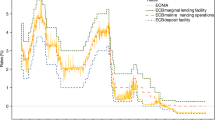Abstract
This paper investigates some common interest rate models for scenario generation in financial applications of stochastic optimization. We discuss conditions for the underlying distributions of state variables which preserve convexity of value functions in a multistage stochastic program. One- and multi-factor term structure models are estimated based on historical data for the Swiss Franc. An analysis of the dynamic behavior of interest rates generated with these models reveals several deficiencies which have an impact on the performance of investment policies derived from the stochastic program. While barycentric approximation is used here for the generation of scenario trees, these insights may be generalized to other discretization techniques as well.
Similar content being viewed by others
References
J.R. Birge and R.J.-B. Wets, Designing approximation schemes for stochastic optimization problems, in particular for stochastic programs with recourse, Mathematical Programming Study 27 (1986) 54–102.
F. Black, E. Derman and W. Toy, A one-factor model of interest rates and its application to treasury bond options, Financial Analysts Journal 46 (1990) 33–39.
M.J. Brennan and E.S. Schwartz, An equilibrium model of bond pricing and a test of market efficiency, Journal of Financial and Quantitative Analysis 17 (1982) 301–329.
A. Bühler, Einfaktormodelle der Fristenstruktur der Zinssätze(Haupt, 1995).
E. Canabarro, Comparing the dynamic accuracy of yield-curve-based interest rate contingent claim pricing models, Journal of Financial Engineering 2 (1993) 365–401.
K.C. Chan, G.A. Karolyi, F.A. Longstaff and A.B. Sanders, An empirical comparison of alternative models of the short-term interest rate, Journal of Finance 47 (1992) 1209–1227.
R.-R. Chen and L. Scott, Maximum likelihood estimation for a multifactor equilibrium model of the term structure of interest rates, Journal of Fixed Income 3 (1993) 14–31.
Z. Chen, M.A.H. Dempster and N. Hicks-Pedrón, Towards sequential sampling algorithms for dy-namic portfolio management, in: Operational Tools in the Management of Financial Risks,ed. C.Zo-pounidis (Kluwer, 1998) pp. 197–211.
R. Cont, Modeling term structure dynamics: an infinite dimensional approach, International Journal of Theoretical and Applied Finance 3 (2000), to appear.
J.C. Cox, J.E. Ingersoll and S.A. Ross, A theory of the term structure of interest rates, Econometrica 53 (1985) 385–407.
G.B. Dantzig and G. Infanger, Multi-stage stochastic linear programs for portfolio optimization, An-nals of Operations Research 45 (1993) 59–76.
M.A.H. Dempster, The expected value of perfect information in the optimal evolution of stochas-tic problems, in: Stochastic Differential Systems, eds. M. Arato, D. Vermes and A.V. Balakrishnan (Springer, 1981) pp. 25–40.
J. Dupačová, M. Bertocchi and V. Moriggia, Postoptimality for scenario based financial planning mod-els with an application to bond portfolio management, in: World Wide Asset and Liability Modeling, eds. W.T. Ziemba and J.M. Mulvey (Cambridge University Press, 1998) pp. 263–285.
N.C.P. Edirisinghe, New second-order bounds on the expectation of saddle functions with applications to stochastic linear programming, Operations Research 44 (1996) 909–922.
N.C.P. Edirisinghe and W.T. Ziemba, Tight bounds for stochastic convex programs, Operations Re-search 40 (1992) 660–677.
N.C.P. Edirisinghe and W.T. Ziemba, Bounding the expectation of a saddle function with application to stochastic programming, Mathematics of Operations Research 19 (1994) 314–340.
N.C.P. Edirisinghe and W.T. Ziemba, Bounds for two-stage stochastic programs with fixed recourse, Mathematics of Operations Research 19 (1994) 292–313.
B. Forrest, K. Frauendorfer and M. Schürle, A stochastic optimization model for the investment of savings account deposits, in: Operations Research Proceedings 1997, eds. P. Kischka, H.-W. Lorenz, U. Derigs, W. Domschke, P. Kleinschmidt and R. Möhring (Springer, 1998) pp. 382–387.
K. Frauendorfer, Stochastic Two-Stage Programming(Springer, 1992).
K. Frauendorfer, Multistage stochastic programming: Error analysis for the convex case, Mathemati-cal Methods of Operations Research 39 (1994) 93–122.
K. Frauendorfer, Barycentric scenario trees in convex multistage stochastic programming, Mathemat-ical Programming (Series B) 75 (1996) 277–293.
K. Frauendorfer and C. Marohn, Refinement issues in stochastic multistage linear programming, in: Stochastic Programming Methods and Technical Applications, eds. K. Marti and P. Kall (Springer, 1998) pp. 305–328.
J. Hull and A. White, Pricing interest rate derivative securities, Review of Financial Studies 3 (1990) 573–592.
G. Infanger, Planning under Uncertainty(Boyd & Fraser, Danvers, 1994).
P. Kall, A. Ruszczyński and K. Frauendorfer, Approximation techniques in stochastic programming, in: Numerical Techniques for Stochastic Optimization, eds. Y. Ermoliev and R.J.-B. Wets (Springer, 1988) pp. 33–64.
S. Leithner, Valuation and Risk Management of Interest Rate Derivative Securities(Haupt, 1992).
R. Litterman and J. Scheinkman, Common factors affecting bond returns, Journal of Fixed Income 1 (1991) 54–61.
J.M. Mulvey, Financial planning via multi-stage stochastic programs, in: Mathematical Program-ming: State of the Art 1994, eds. J.R. Birge and K.G. Murty (University of Michigan, 1994) pp. 151–171.
W.H. Press, S.A. Teukolsky, W.T. Vetterling and B.P. Flannery, Numerical Recipes in C, 2nd ed. (Cambridge University Press, 1992).
M. Schürle, Zinsmodelle in der stochastischen Optimierung(Haupt, 1998).
O. Vasicek, An equilibrium characterization of the term structure, Journal of Financial Economics 5 (1977) 177–188.
K.R. Vetzal, Stochastic volatility, movements in short term interest rates, and bond option values, Journal of Banking and Finance 21 (1997) 169–196.
Q.H. Vuong, Likelihood ratio tests for model selection and non-nested hypotheses, Econometrica 57 (1989) 307–333.
S.A. Zenios, A model for portfolio management with mortgage-backed securities, Annals of Opera-tions Research 43 (1993) 337–356.
S.A. Zenios and M.S. Shtilman, Constructing optimal samples from a binomial lattice, Journal of Information and Optimization Sciences 14 (1993) 125–147.
Author information
Authors and Affiliations
Rights and permissions
About this article
Cite this article
Frauendorfer, K., Schürle, M. Term Structure Models in Multistage Stochastic Programming: Estimation and Approximation. Annals of Operations Research 100, 189–209 (2000). https://doi.org/10.1023/A:1019223318808
Issue Date:
DOI: https://doi.org/10.1023/A:1019223318808




